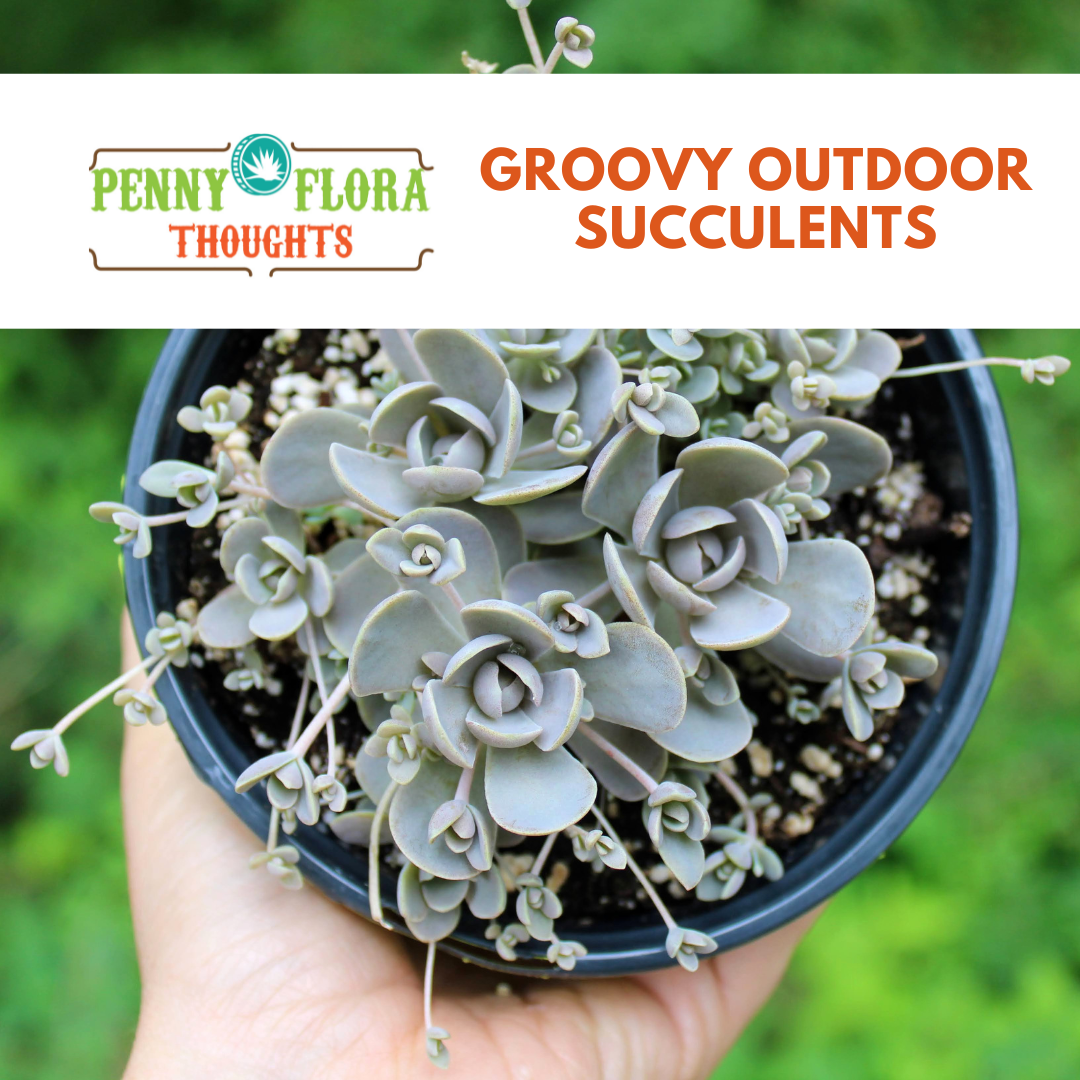Succulents are legendary at Groovy Plants Ranch. For 15 years, Jared has been growing and propagating both hardy and tender ones since he founded the business. For this post, we’re focusing on hardy succulents – tough ones that can be grown outdoors year-round here in Ohio and other northern states. You’ll find they can be highly collectible -- even addicting -- and perfect planted in rock gardens to create fascinating little worlds to enjoy close up. Plus, they’re long-lived or as Jared says “they come without expiration dates.”

At our entry rock garden, many customers pause to admire beauties like sculptural agaves, flowering tall sedums and mounds of colorful stonecrops tucked among boulders. Thousands more fill tables inside and outside our greenhouses. There’s virtually a sea of colorful and shapely succulents including mini jelly bean sedums, stunning rosettes and intricate creepers in blues, greens, purples and golds. Even more sedums spill from our Mercantile rooftop and the repurposed gutters along the Trading Post. You might say we’re a little succulent crazy!
Getting Started
If you’ve tried succulents indoors, you already know how easy-care they can be. Many are native to arid desert and alpine regions, so they’ve adapted to hold water in their leaves and stems to withstand drought conditions. In the home landscape, they thrive on neglect and only need occasional watering. The key is to plant them in a sunny, well-drained location. Count on them to do most of their growing in the spring and summer then go dormant or semi-dormant in winter. They are incredibly frost hardy. Just make sure they do not sit in water or they will rot.
There’s an abundance of cold-hardy varieties to collect. We love all the cool shapes and colors including some that change with the seasons. Many even feature colorful blooms that attract pollinators.
Easy-Care Hardy Succulents
Here are a few favorites for beginners:
- Hens and Chicks: These alpine succulents feature thick fleshy leaves that form rosettes in a host of hues. Each larger “hen” produces smaller “chick” offsets that can form tight clumps or be cut to grow more plants. Their botanic name Sempervivium meaning “alive forever” hints at their toughness. Try ‘Purple Passion’ with a ring of purple offsets; ‘Cobweb’ with bright green rosettes covered in white webbing; and ‘Ruby’ with maroon foliage and pink blooms. ‘Gold Nugget’ turns from yellow-green in the summer to a deep gold and red in cooler months.

- Groundcover Sedums: These creeping sedums are perfect to place in rock gardens, along walkways, or cascading over boulders and stone walls. In bloom, many form carpets of color. A few foliage favorites include 'Tricolor' in striking red, white and green; ‘Voodoo’ in deep red; ‘Angelina’ in gold; and Orostachys iwarenge 'Dunce Cap' in silvery-grey. In winter, Dunce Cap’s rosettes dry up into tiny balls, disconnect and roll themselves to other parts of the garden where they’ll grow the next season. So fascinating!

- Tall Sedums: These easy-care perennials offer plenty of pollinator appeal and four-season interest. Many have colorfully mounded foliage and fall flower clusters. Try ‘Plum Dazzled’ Sunsparkler sedum with purple foliage and magenta blooms; ‘T-Rex’ with toothed foliage and pink flowers; ‘Dark Magic’ with purple-black foliage and deep pink blooms; and ‘Mohave Jewels Diamond’ with purple-red foliage and bubblegum pink flowers.
- Prickly Pears: These succulents are known for their flat, oval-shaped pads, showy flowers and tasty fruits. Many hardy ones can endure temperatures as low as -20°F. We offer several premium varieties including Opuntia tortispina, Opuntia sanguinea and Opuntia polyacantha. Also, try Opuntia ‘Mulberry Creek’ with stunning flowers in rose and cream.
Extra-Care Hardy Succulents
Hardy agaves and ice plants are two other types of outdoor succulents that can successfully grow in colder climates given they’re planted in mounded sandy, gritty soil. The selections below are hardy to zone 5a but need to be kept dry especially in winter to avoid root rot.
- Hardy Agaves: These highly architectural plants make a bold statement in the garden. Try Agave parryi var. truncata with silver-blue rosettes and red-brown toothed edges; Agave havardiana with powdery blue rosettes and summer-flowering spikes; Agave lechuguilla with narrow green spikey leaves; and Agave montana (Mountain agave) with gorgeous green leaves and cinnamon red teeth. Agave virginica is a native agave that we grow from seed.

- Ice Plants: Unlike their name, ice plants love the heat and are super drought tolerant once established. They’re adored for their profusion of showy flowers that open in mid-morning and close at night. Try the Ocean Sunset series with violet or orange blooms or the Jewel of the Desert series with garnet, ruby and peridot blooms.

Planting Hardy Succulents in a Rock Garden
Hardy succulents are perfect for a rock garden. To plant your own, find a sunny spot along a patio, a dry pocket along a border or a south-facing slope. The key is good drainage. We start by placing boulders in a rough border then build up a shallow mound of soil in the center. Add a few more river rocks or smaller boulders. Next add plants starting with one or more statement specimens like agaves. Tuck in smaller plants among the rocks, mixing textures, shapes and colors. Beyond succulents add heat-loving, drought-tolerant perennials like yuccas, lavender, sea hollies, coneflowers and blanket flowers. Finally, top dress the area with pea gravel or crushed granite to keep the plants' crowns dry and help control weeds. Water thoroughly once; after that, most plants will subsist on normal rainfall.

Learn More
Check out these resources for more information on hardy succulents, grow tips and planting a rock garden:
- Succulent groups: Central Ohio Cactus and Succulent Society and Midwest Cactus and Succulent Society
- Books: Plant Lover’s Guide to Sedum by Brent Horvath, Succulents Simplified by Debra Lee Baldwin or Rock Gardening by Joseph Tychonievich
- Succulents 101 video: Liz shares tips for growing both indoor and outdoor succulents.


7 comments
Looking for mountain rose varieties…?
Looking for Venus fly traps
Do you carry yucca perennials?
Do you carry Peach and Apple Trees? Range of cost?
Do you grow white aloe or boudarvia?